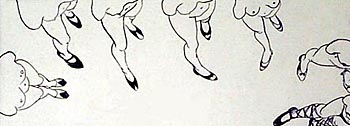Printmaking Definitions: Lithography
Intaglio / Etching | Drypoint | Lithography | Relief Printing | Screen Collograph | Cyannotypes | Viscosity Printing
Process:
The design is drawn on a stone (or certain types of plates) with a greasy crayon or ink.
The stone is then processed with a solution of gum arabic, a few drops of nitric acids, depending on the density of the image. The solution is buffed down so the surface is dry, then the drawing is removed using mineral spirits, leaving the gum arabic stencil in place.
The grease is then reinserted, and then wiped off.
The gum stencil is then removed with water.
Water adheres to the bare stone and not the greasy areas, while the printing ink does the opposite--it sticks to the greasy areas and not the wet stone.
At this point a roller charged with very stiff litho ink is applied quickly to the stone recharging the drawn areas with a thin layer of ink that is built up through several passes.
The stone must be kept wet with a cellulose sponge, so the white areas do not accept ink.
The inking is usually done while the stone is positioned on the press.
When fully charged, a piece of paper is then placed on the stone, then a static paper next, then a thick layer of plastic is placed on top of both and squeezed through the press.
In the intaglio process the press bed is rolled through. In the litho press the press bed is pressurized then squeezed through.
Example of a lithograph:
Colour lithograph by Gisele
This image had four printings; yellow, red, blue and black.
Illustrations
-
See also: A Glossary of Printmaking terms from the Cleveland Museum

Pulling the paper off the litho stone after it has been squeezed through the press.
You tube links:
Pressure + Ink: Lithography Process - The Museum of Modern Art
Printmaking Processes: Lithography - Minneapolis Institute of Art
Lithograph print process - sugioprints
The black and white image above ia from the Donald Staff, Deli Sacilotto book entitled, "Printmaking"
Created by Gisele Beaupre ©

